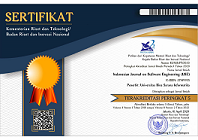Pengembangan Sistem Informasi Presensi Menggunakan Metode Waterfall
Abstract
Abstrak
Pemantauan kehadiran dalam instansi atau presensi sangat penting. Daftar hadir harus dibuat tertib, rapi dan up to date. Pada saat pandemi Covid-19, pegawai/pelajar/mahasiswa dikurangi jam kerjanya, dibagi ada yang Working From Office (WFO) atau Working From Home (WFH), pelajar/mahasiswa ada kegiatan belajar dari rumah. Presensi tetap dilakukan karena sangat penting. Sistem presensi konvensional yang mengharuskan hadir di tempat kerja harus diganti dengan sistem baru yang lebih fleksibel secara online sehingga presensi dapat dilakukan di kantor atau di rumah sesuai jadwal WFO atau WFH. Metode Pengembangan Perangkat Lunak dalam pengembangan Sistem Informasi Presensi ini menggunakan metode pengembangan software Waterfall. Metode Waterfall dipilih karena tim project lebih mengutamakan kualitas aplikasi jika dibandingkan dengan jadwal dan biaya, karena dalam metode ini terdapat kontrol yang ketat pada siklus hidup project dan menggunakan dokumentasi. Hasil dari penelitian ini adalah Sistem Informasi Presensi yang dikembangkan dengan metode pengembangan software Waterfall yang bertujuan untuk memberikan solusi permasalahan presensi karyawan dan siswa di masa pandemi Covid-19.
Kata kunci : sistem informasi presensi, waterfall model
Abstract
Monitoring the presence or presence in an agency is very important. Attendance lists must be organized, neat and up to date. During the Covid-19 pandemic, employee/student working hours are reduced, divided into Working From Office (WFO) or Working From Home (WFH), students/students have learning activities from home. Attendance is still done because it is very important. The conventional attendance system that requires attendance at work must be replaced with a new, more flexible online system so that attendance can be done at the office or at home according to the WFO or WFH schedule. Software Development Method in the construction of this Attendance Information System using the Waterfall software development method. The Waterfall method was chosen because the project team prioritized application quality over schedule and cost, because in this method there is strict control over the project life cycle and the use of documentation. The result of this study is an Attendance Information System which was developed with the Waterfall software development method which aims to provide solutions to the problem of employee and student absenteeism during the Covid-19 pandemic.
Keywords: attendance information system, waterfall model
Full Text:
PDFReferences
Amelia, & Suhendi, H. (2020). APLIKASI ABSENSI PENGENALAN WAJAH BERBASIS ANDROID DENGAN GLOBAL POSITIONING SYSTEM. 1(1), 18–24. http://eprosiding.ars.ac.id/index.php/pti/article/view/151
Aulia, D. S., Wijayanto, P. W., Ing, S. P., Hum, M., & Rosely, E. (2019). Aplikasi Pengawasan Dan Penilaian Tenaga Kerja Kontrak Berbasis Web ( Studi Kasus : Bnnp Jabar ) Web Based Application for Monitoring and Contract Labor Assessment ( Case Study : Bnnp Jabar ). 5(2), 1084–1092. https://openlibrarypublications.telkomuniversity.ac.id/index.php/appliedscience/article/view/9965
Ayu, F., & Sholeha, W. (2019). Rancang bangun sistem informasi penjadwalan mata pelajaran berbasis web pada smart center pekanbaru. Intra-Tech, 3(1).
Farell, G., Saputra, H. K., & Novid, I. (2018). Rancang Bangun Sistem Informasi Pengarsipan Surat Menyurat (Studi Kasus Fakultas Teknik Unp). Jurnal Teknologi Informasi Dan Pendidikan (JTIP), 11(2), 56–62.
Firman, A., Wowor, H. F., Najoan, X., Teknik, J., Fakultas, E., & Unsrat, T. (2016). Sistem Informasi Perpustakaan Online Berbasis Web. E-Journal Teknik Elektro Dan Komputer, 5(2), 29–36.
Hidayat, C. (2021). Pengertian Metode Waterfall dan Tahap-Tahapnya. https://ranahresearch.com/metode-waterfall/
Kurniawan, Y. I., Nurjaman, A. L., & Afuan, L. (2021). Sistem Presensi Karyawan Menggunakan Quick Response Code di CV . Jenderal Software. 11(September), 168–182. https://doi.org/10.34010/jati.v11i2
Muchlis, N. F. (2020). Monitoring Keaktifan Mahasiswa Selama Perkuliahan Online Pada Masa Pandemi Covid-19 Melalui Aplikasi Absensi Dan Penilaian Berbasis Mobile. JIRA: Jurnal Inovasi Dan Riset Akademik, 1(4), 350–359. https://doi.org/10.47387/jira.v1i4.59
Purwaningtias, D., Rahayuningsih, P. A., Studi, P., Informasi, S., Kota, K., Studi, P., Informasi, S., & Bina, U. (2021). Sistem informasi pasien posyandu pada poskesdes kalimas. 5(2), 300–309. https://www.jurnal.kaputama.ac.id/index.php/JTIK/article/view/597
Ravi, Yadav, S., Jindal, R., & Anand, S. (2020). A Study on Comparison of UML and ER Diagram Abstract : May, 7575–7580. https://irjet.com/archives/V7/i5/IRJET-V7I51425.pdf
Suandi, A., Khasanah, F. N., & Retnoningsih, E. (2017). Pengujian Sistem Informasi E-commerce Usaha Gudang Cokelat Menggunakan Uji Alpha dan Beta. Information System for Educators and Professionals, 2(1), 61–70. https://media.neliti.com/media/publications/234474-pengujian-sistem-informasi-e-commerce-us-2bea597f.pdf
Supriyono, S. (2020). Software Testing with the approach of Blackbox Testing on the Academic Information System. International Journal of Information System and Technology, 3(2), 227–233. http://ijistech.org/ijistech/index.php/ijistech/article/view/54
Zulfa, F., Siahaan, D. O., Fauzan, R., & Triandini, E. (2020). Inter-Structure and Intra-Structure Similarity of Use Case Diagram using Greedy Graph Edit Distance. 2020 2nd International Conference on Cybernetics and Intelligent System (ICORIS). https://ieeexplore.ieee.org/abstract/document/9320840/
DOI: https://doi.org/10.31294/ijse.v7i2.11091

This work is licensed under a Creative Commons Attribution-NonCommercial-ShareAlike 4.0 International License.
ISSN : 2714-9935


Published by LPPM Universitas Bina Sarana Informatika
Jl. Kramat Raya No.98, Kwitang, Kec. Senen, Kota Jakarta Pusat, DKI Jakarta 10450
This work is licensed under a Creative Commons Attribution-ShareAlike 4.0 International License









